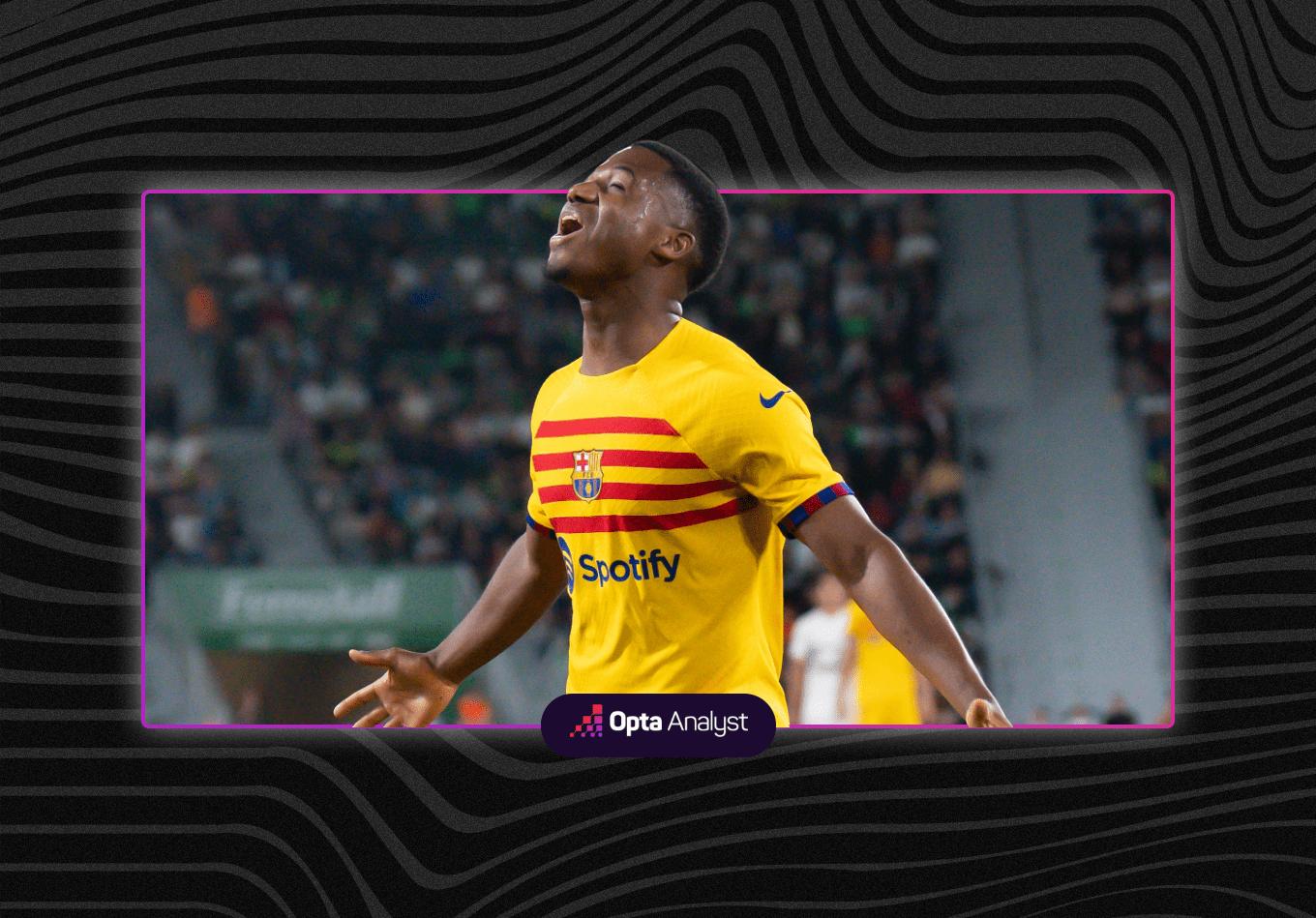Fans of the Football Manager franchise will know the feeling. You’re in the middle of taking Ross County to UEFA Champions League glory and you notice a strange happening within the game that just wouldn’t happen in real life.
“Haha, Ansu Fati is joining Brighton and Hove Albion?! What a wacky simulation this is.”
Then you realise you stopped playing an hour ago and are now flicking through social media in (sort of) real life.
Yes, Barcelona and Spain star Ansu Fati – a man once labelled as the heir apparent to Lionel Messi – is reportedly on his way to Brighton on a season-long loan deal.
It’s not ridiculous to think the 20-year-old would want to join Brighton. Everyone has seen the upward trajectory of the club in recent years and they consistently play some of the most attractive football in Europe under Roberto De Zerbi.
The question is more about why Barcelona are allowing the player to leave the Camp Nou, albeit only on loan?
On 25 August 2019, at the age of just 16, Fati was handed his Barça first-team debut by Ernesto Valverde against Real Betis, making him the club’s second-youngest debutant in history at the time. It wasn’t long before he was breaking records. Just six days after making his debut, Fati scored his first goal against Osasuna, making him Barça’s youngest-ever goalscorer, and the third youngest in La Liga history.
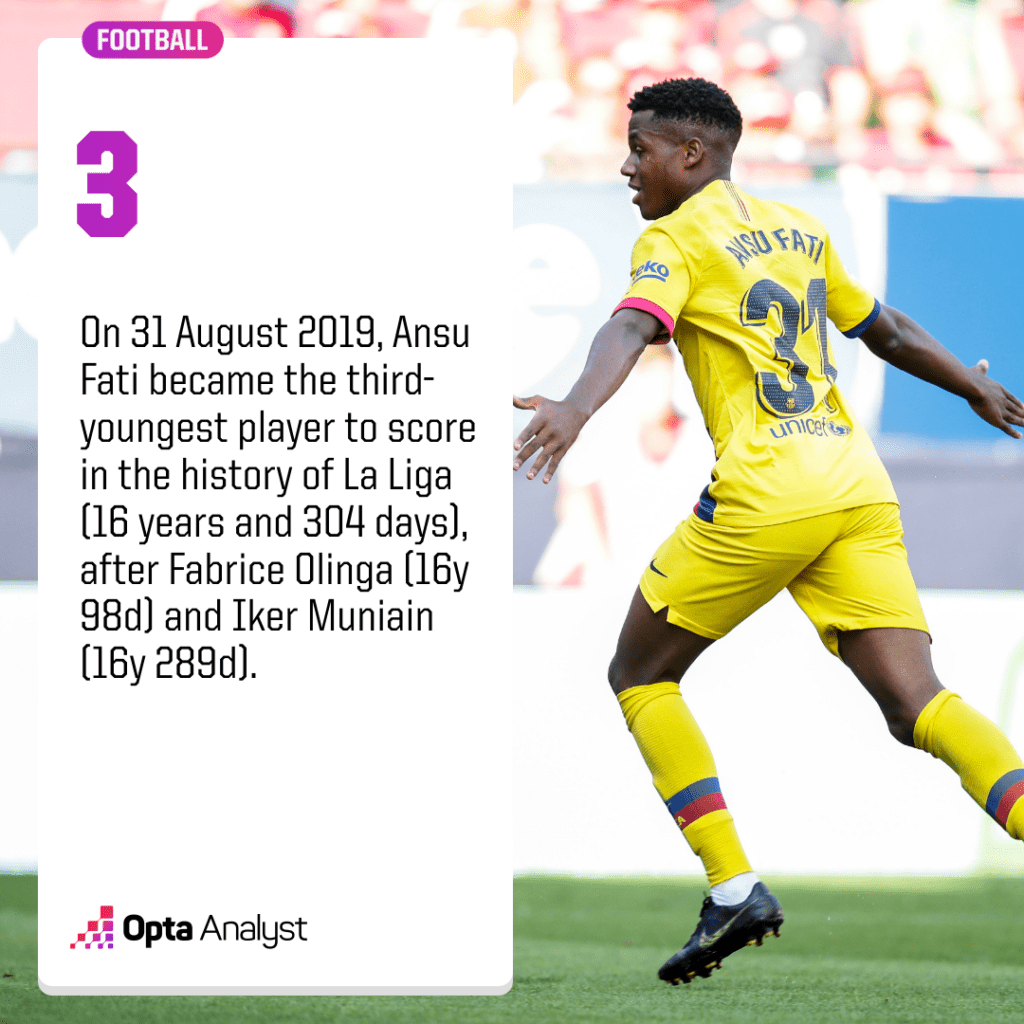
In just his third appearance, Fati made the starting line-up against Valencia in a 5-2 win, scoring inside two minutes and providing an assist for Frenkie de Jong just five minutes later, making him the youngest player to score and assist in a game in La Liga, and the youngest to score at the Camp Nou.
His appearance against Borussia Dortmund three days later made him the youngest player to feature for Barça in the Champions League, while his winner off the bench against Inter in their next group game made him the youngest goalscorer in the competition’s history.
International football then needed some records ticking off, and Fati duly obliged, becoming Spain’s youngest player since 1936 when he featured against Germany, and becoming the nation’s youngest ever goalscorer when he netted in a 4-0 win over Ukraine.
Some believed he also became the youngest player to score in El Clásico when he did so in a 3-1 home defeat to Real Madrid in October 2020, though it was suggested that Alfonso Navarro may have done so three days younger back in 1947. Either way, the world was very much at Fati’s feet.
Then in a cruel twist of fate, while playing Betis in November 2020 – the team he had made his debut against – Fati suffered a ruptured inner meniscus in his left knee after a challenge from Aïssa Mandi. Issues with his recovery from his initial surgery led to follow-up surgeries, with him undergoing four in total, and it taking almost 11 months for him to return to action. When he did, he wore Messi’s iconic number 10 shirt after the Barça legend had left for Paris Saint-Germain. It was another show of faith in Fati, but was perhaps also an unnecessarily bigger weight around his shoulders.
Naturally, Fati scored within 10 minutes of coming off the bench in his return game against Levante, but the rest of his 2021-22 campaign continued to be disrupted by injuries, and his career has been stop-start ever since.
He began the 2022-23 season well enough, coming off the bench against Real Sociedad to become the first Barcelona player to be directly involved in three goals in a league away game as a substitute in the 21st century (one goal and two assists). Fati made 51 appearances overall last season, but only 14 of those were starts as Xavi often opted for Ousmane Dembélé or Gavi in his frontline alongside Robert Lewandowski and Raphinha.
Fati was still able to produce 10 goals and three assists to help Barça win La Liga, but he was noticeably dribbling less than previously. His explosive pace was still there, but perhaps not in the same way it was prior to his knee troubles, with suggestions the player was not trusting his body as much, understandably in the circumstances.
In the 2019-20 season across his 33 games, Fati averaged 5.1 dribbles attempted per 90 minutes, but last season, that was down to just 3.3 dribbles per 90. While that may have been down to not trusting his body as much as before, it could also simply have been due to the difference in playing style and instructions from Valverde to Xavi. Interestingly, his dribble success rate broadly stayed the same (42.3% in 2019-20 to 42.4% in 2022-23).
He has also become a player who looks for goal more since returning from his first big injury. From his debut to his knee injury in November 2020, Fati averaged 3.1 shots per 90 for Barcelona, whereas he has averaged 4.5 shots per 90 since his comeback in September 2021. He also averaged 1.4 chances created from open play per 90 pre-injury, which has dipped to 1.0 since his return.
He was heavily involved when he did play, though, with only Dembélé and Raphinha involved in more attacking sequence per 90 for Barça in La Liga than his 6.7 (min. 900 minutes), but he still struggled to convince Xavi to give him regular starts.
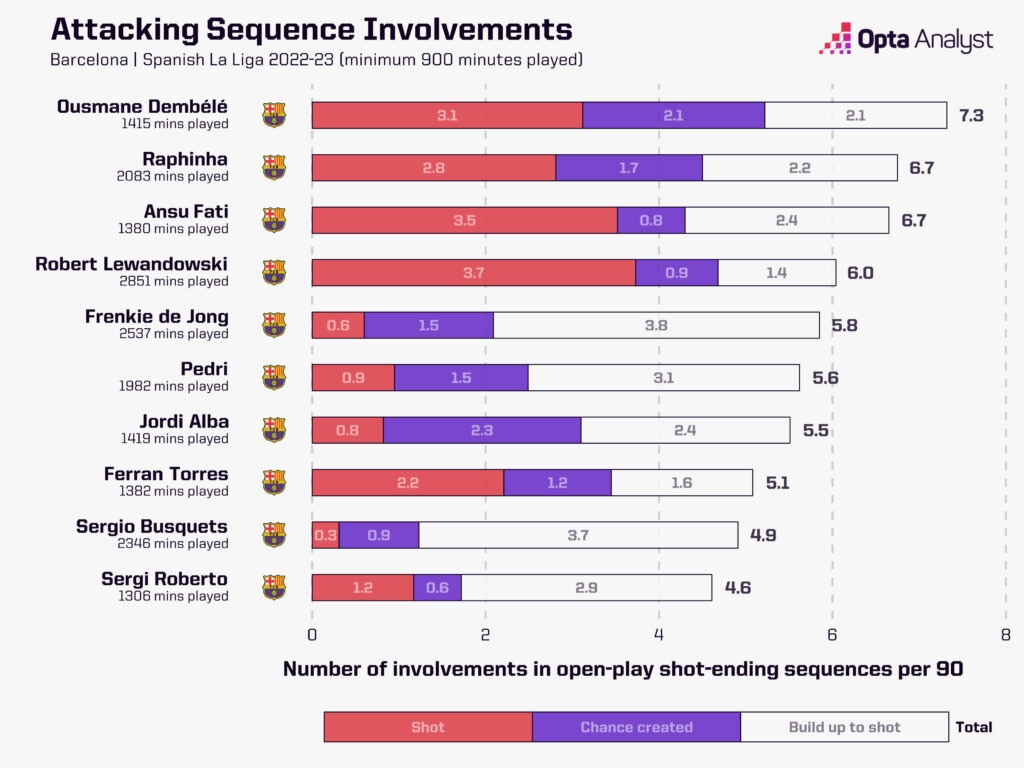
The lack of faith from his manager continued into this season, with Fati making just three sub appearances for a combined total of 47 minutes, somewhat ironically being overlooked for 16-year-old wonderkid Lamine Yamal, who recently became the youngest player to register an assist in La Liga for Barcelona in the 21st century, beating Fati’s record. It therefore perhaps isn’t that surprising that both Barça and the player have reportedly agreed on a temporary arrangement that will see him play in the Premier League for the remainder of this campaign.
But where will he fit at Brighton?
Reports suggest the potential loan deal includes no option to buy, with Brighton paying 80% of his fairly hefty wages, so surely the intention is for Fati to play far more often than not. The curious thing though is that arguably Brighton’s best player currently fills his position.
Kaoru Mitoma has been a revelation since returning from a loan spell at Union Saint-Gilloise, averaging 4.8 dribbles per game in the Premier League since the start of last season, with a success rate of 48.5%, providing eight goals and seven assists. As you can see from our player comparison below, Fati is a more direct player than Mitoma, also having a lot of touches in the opposition box but attempting twice as many shots, while the Japan international creates more chances.
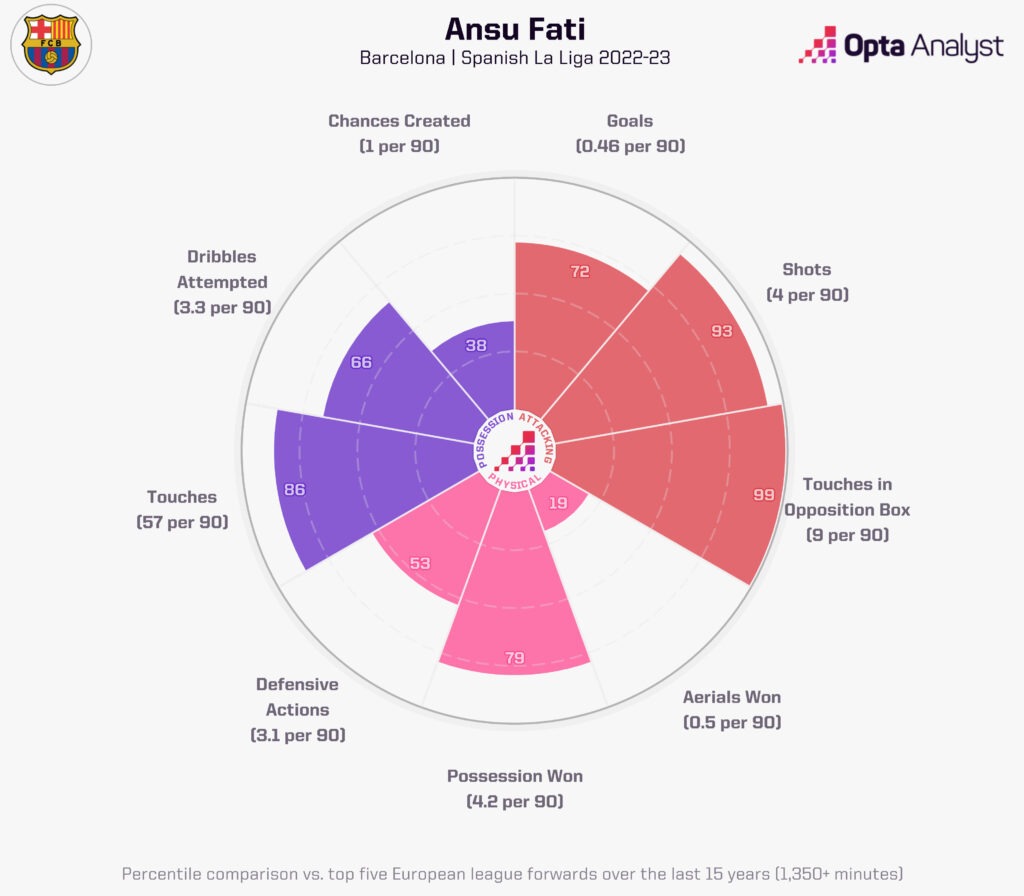
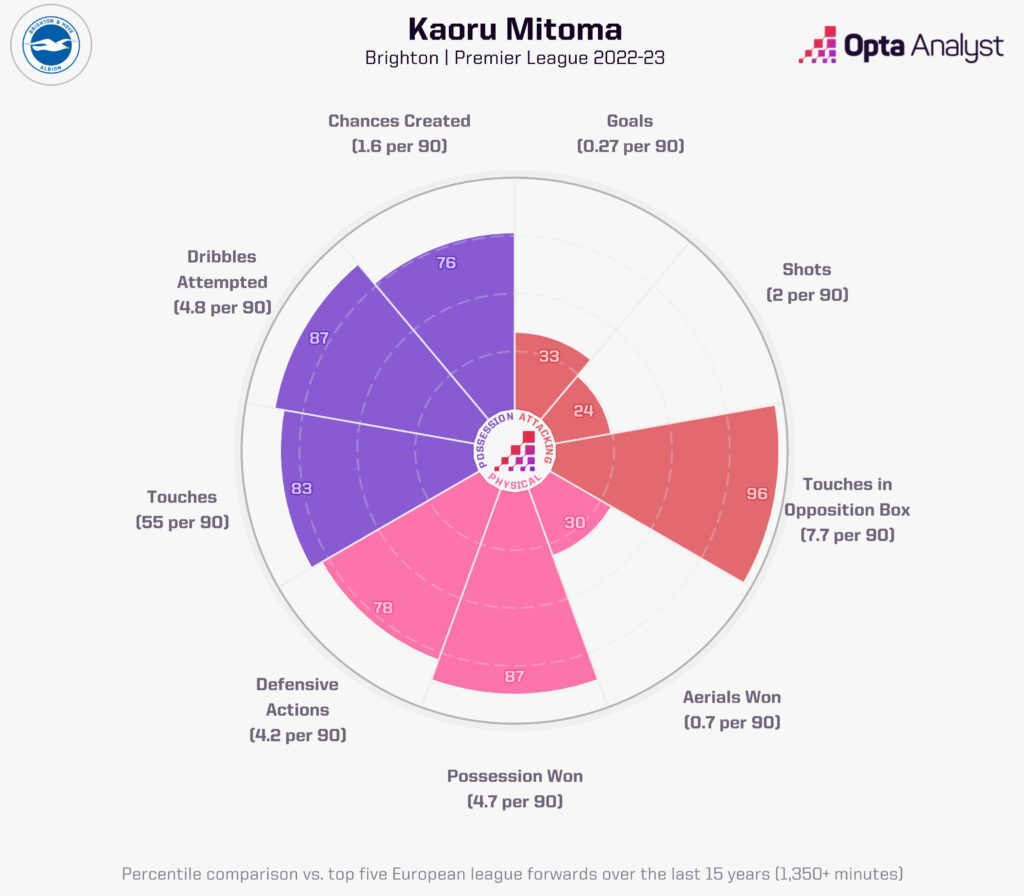
You could argue that either should be able to play on the right instead of the left, but neither really has much experience of doing so. Fati did sometimes play as a central striker for Xavi last season, with 22% of his La Liga minutes coming there, but then Brighton have the very promising Evan Ferguson and £30 million signing João Pedro to consider as well.
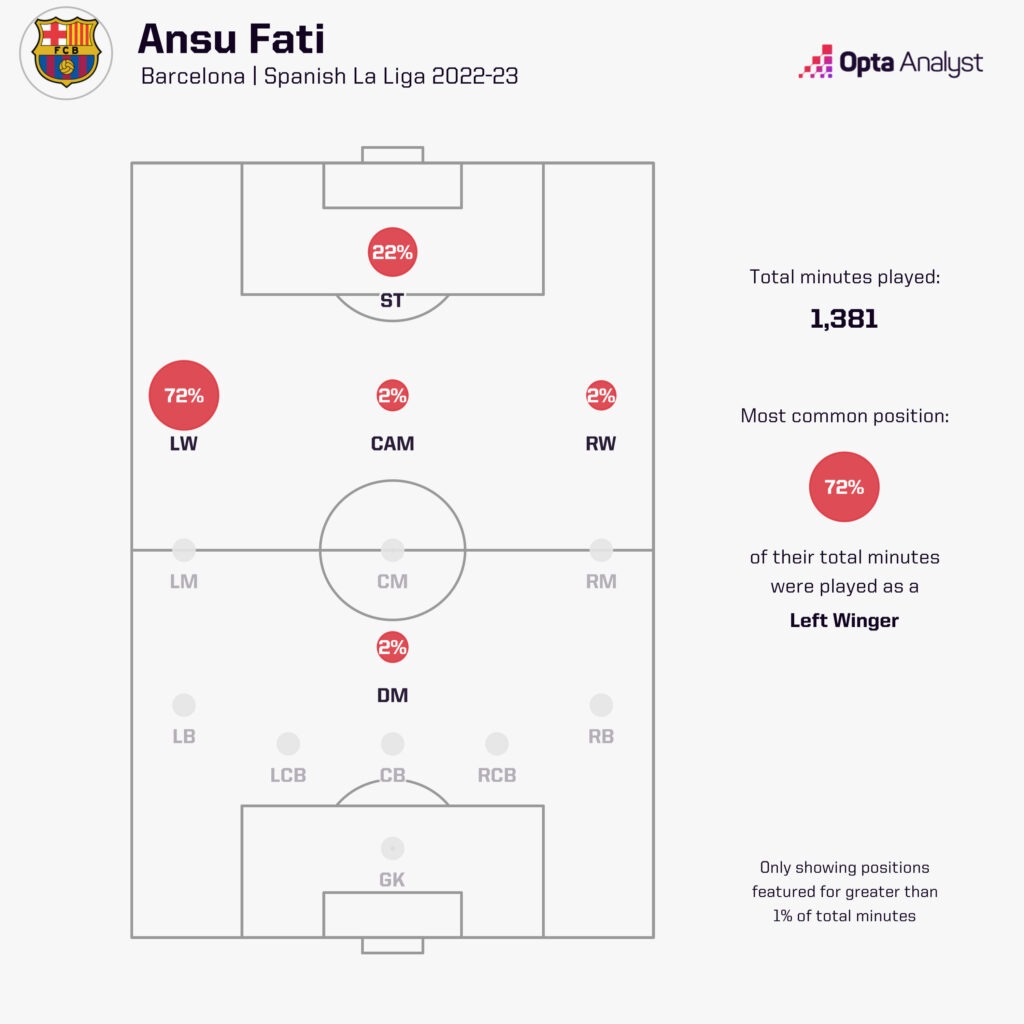
De Zerbi’s men do of course have a UEFA Europa League campaign to navigate, so the minutes will certainly be there for Fati. That the deal with Brighton has no purchase option suggests that maybe Barcelona haven’t given up on him getting back to his best, and presumably they’re hoping Brighton can work the same magic on him as they have done for the likes of Marc Cucurella, Alexis Mac Allister, Moisés Caicedo and Mitoma among others in recent years.
It might have been unfair to label Fati ‘the next Messi’ (perhaps he can be the next Glenn Murray?) but it’s sure to be a fascinating year for him and the rest of us, and who knows? This could be the start of Fati getting back on course to fulfilling his incredible potential.
Enjoy this? Subscribe to our mailing list to receive exclusive weekly content. And follow us on Twitter too.
